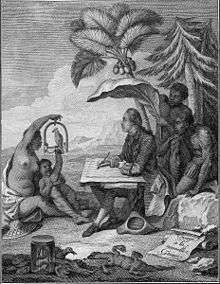Pierre Sonnerat

Pierre Sonnerat (18 August 1748 – 31 March 1814) was a French naturalist and explorer.
Sonnerat was the nephew of the botanist Pierre Poivre (mother of Pierre Sonnerat, Benoîte Poivre, was a cousine of Pierre Poivre). He made several voyages to southeast Asia, visiting the Philippines and Moluccas between 1769 and 1772, and India and China from 1774 to 1781. He was the first person to give a scientific description of the south Chinese fruit tree lychee. He is the person who misinterpreted the call of a helpful Malagasy guide who had spotted a lemur and shouted "indri!" ("look!" in Malagasy). Sonnerat took this to be the animal's name, and it is still known as an Indri (Indri indri) today (the actual Malagasy name is babakoto). The birds Dacelo novaeguineae and Pygoscelis papua, neither of which are found in New Guinea (Papua), were also misnamed due to Sonnerat.[1]
His books included Voyage à la Nouvelle-Guinée (1776) and Voyage aux Indes orientales et à la Chine, fait depuis 1774 jusqu'à 1781 (1782). The standard botanical author abbreviation Sonn. is applied to plants he described. His name is used in the specific name of the grey junglefowl (Gallus sonneratii).
Pierre Sonnerat spoke out against the prevalent racism in the European circles of his time. During his visits to Asia he marvelled at the rich culture of the Indians. In one of his books Sonnerat writes "Ancient India gave to the world its religions and philosophies: Egypt and Greece owe India their wisdom and it is known that Pythagoras went to India to study under Brahmins, who were the most enlightened of human beings."
See also
References
- ↑ Isaak, M. (2008). Curiosities of Biological Nomenclature. Accessed 2008-12-28.
- ↑ IPNI. Sonn.
External links
- Pierre Sonnerat (1776) Voyage a la Nouvelle Guinée - from the Linda Hall Library; Illustrations de Voyage à la Nouvelle Guinée
 from Gallica
from Gallica